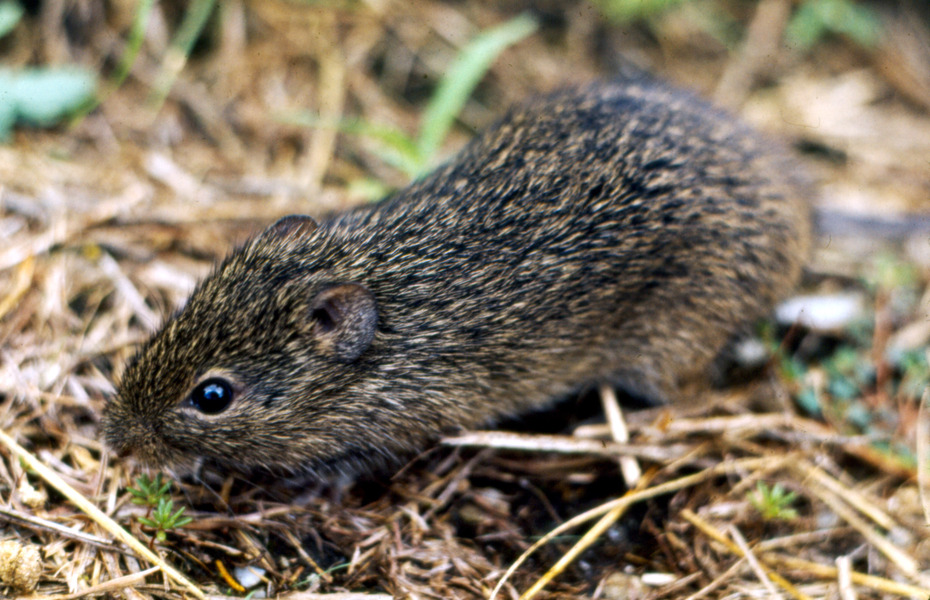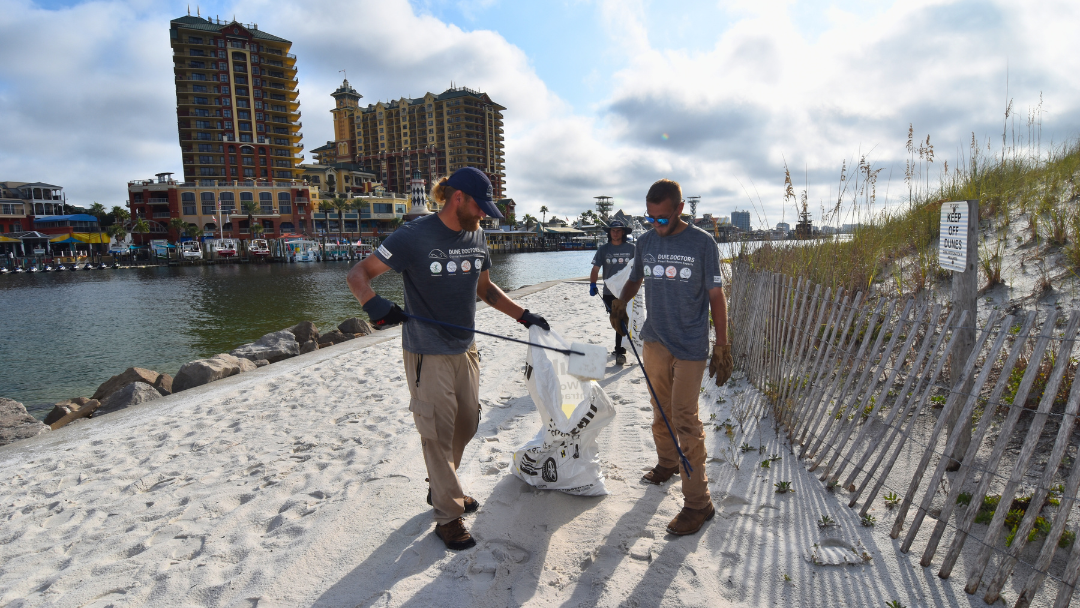Snake Sightings Are Typically Rare on the Beach
Concerned and curious beachgoers often ask me if I encounter snakes while doing fieldwork. In my experience, I have only found snakes on dunes with poor maintenance. Coincidentally, I have met homeowners who actively warn people of snake presence in hopes of minimizing foot traffic on their dunes. To their dismay and my surprise, they created an irresistible attraction for teenage kids (locals and tourists alike) who, in search of excitement, ended up spending enormous amounts of time looking for the elusive “sand viper”, “dune rattlesnake,” or “reticulated sand snake” in the dunes.
Unless you are a teenager looking for a thrill, chances are you are not coming to the beach hoping to find snakes. Typically, the snakes that will travel to the dunes closest to a home or condominium are harmless and a few things can be done to limit their presence. An effective long-term strategy to dissuade snakes from staying on your grounds is to control the non-native rodent populations through routine maintenance of dune vegetation and consistent trash removal. Snakes follow the migration of their food sources, and the responsibility falls on Coastal Stewards to avoid creating environments that unwanted pests are attracted to.
A former associate was visiting a property when he heard a commotion on the pool deck where a family was lounging. A large black snake had slithered over the mother’s foot, and she was incredibly upset. Despite the manager’s best attempts to diffuse the situation, the family will most likely not return and potentially even discourage others from vacationing at that specific location. Through word-of-mouth and social media reviews, the mother’s experience will quickly spread and result in a direct loss of revenue for the property owners.
Snakes Follow Their Prey’s Migration
As a society, we hold an irrational fear of snakes rooted in a misunderstanding of the creatures. For the most part, snakes are timid and gentle animals who desperately avoid humans. But, snakes will migrate towards your property if a consistent food source is available. A concentration of snakes is often a secondary issue that arises when the rat population increases.
There are two main types of non-native rats (invasive): Black Roof Rats and Norway Rats. There is also a native rat (non-invasive), the Hispid Cotton Rat (in addition to our coastal beach mice). Thus, if you observe an increase in the rat population around your property, you should take action to minimize the rodents’ presence.

The Hispid Cotton Rat (pictured above) is completely harmless. A good way to tell a non-native rat apart from the Hispid Cotton rat is that the invasive species’ tail will likely be twice as long as its body.
The Invasive Rat Species Can Be Controlled in Several Ways:
- Through controlling thatch. This is by far the most important issue. Excess thatch is used by the rats for nesting material and hiding places. You can often see their trails through the dune vegetation.
- Through limiting access to commercial food sources. A non-native rat population is often a direct result of the presence of trash on your property.
- By eliminating places to hide around condos and other highly- developed areas. Sod also gives them a hiding place or “carpet” on the sand dunes that non-native rats can hide under and once installed, it usually leads to a permanent residence of non-native rats.
- By removing the berries of cabbage palm trees. Where I have complaints of rats, frequently these trees are fruiting at the time and non-native rats are eating the food source.
De-thatching, or the manual removal of dead plant material from the dunes, is a vital step in the process. Thatch naturally accumulates over time and dries out at the base of dune plants. Excess thatch build-up poses a fire hazard (especially during firework season) and provides a viable habitat for pests to live in. The consistent removal of thatch creates a safer environment on your dunes and lessens the presence of unwanted species. The removal of thatch is a delicate process that should be done by professionals who know how to clear it without uprooting the vegetation that was put in place to secure the dune. Proactive grooming of the dune environment is the solution to curbing rat populations before they attract snakes.
Snakes Are Vulnerable and Federally Protected
It is important to note that mowing and weed-eating are not allowed on the dunes in any county or state. Walton County in Florida published a concise list of general restrictions and regulations regarding dune activity for property owners. Governmental regulation of the dunes vary accordingly, but the Walton County guide is an excellent starting point for you to understand the needs and development restrictions placed on your dune ecosystem.
As far as the snakes themselves, according to The Florida Fish and Wildlife Conservation Commission, snakes pose minimal threat to humans and only strike defensively. Snakes are rarely found around large developments and do not go out of their way to encroach on human spaces. The most common snakes you are likely to encounter around the dunes are not venomous, including the coachwhip, black racer, the grey snake (wooded areas), and the eastern indigo snake. The dusky pygmy rattlesnake, a tiny viper, can be found as well but rarely on open beaches. Of the snakes listed, according to the article “Florida’s Non-venomous Snakes” made available by the city of Winter Park, the black racer and coachwhip are the only diurnal species that hunt in open areas.
For the most part, snakes typically avoid exposing themselves for fear of being spotted by predators. Florida’s Living Beaches, a beach enthusiast’s guide by Blair and Dawn Witherington, further explains that snakes do live in the dunes but only occasionally hunt on the beach. Also, of the snakes found on the coast, the authors emphasize that the Eastern Indigo snake is considered a “threatened species” due to habitat loss and are federally protected (Witherington, 201).
The National Park Service published an announcement to raise awareness regarding the significant drops in snake populations observed throughout the USA. The primary causes listed are disease, water pollution, habitat loss, and environmental degradation. Remember, that snakes are vulnerable and should never be touched or picked up due to their incredibly delicate spines. They never intentionally position themselves to frighten you. Your best response when encountering one is to avoid conflict by simply leaving it alone.
Snakes Are Part of Nature’s Pest Control Team
Ultimately, snakes play a vital role in balancing our ecosystem and ridding our properties of pests. Therefore, the duty falls on us to prevent non-native rat populations before snakes tend to it themselves. Most snake bites occur when people attempt to hold them, and those found along the coastline are harmless and non-venomous. When in doubt, the best approach is to immediately contact your local animal control agency, as they will be capable of safely removing the snake if needed.
Finally, deep in the dune fields, far off the beaten path, and on national seashores, lies the potential risk of encountering rattlesnakes or other poisonous snakes. The biggest ones I have ever seen were in Texas. My word of advice is to always stay on the boardwalks and to stay out of their habitats. They are best seen from a distance as many are endangered and can be easily harmed. For coastal properties specifically, I would say that a thorough cleanup and de-thatching of the dunes combined with regular maintenance to limit food sources and nesting possibilities will tremendously reduce the chances of snakes becoming a significant problem for you.
Commonly Asked Questions
Q: Why am I suddenly seeing snakes on my property?
A: Snakes change their habitat in response to changes in their food sources and shelter. If their old habitat is no longer viable, they will seek another home and may find yours just lovely.
Q: What about my property makes it attractive to snakes?
A: Snakes are attracted to places with a ready food source. Snakes will follow if you have rats living on or near your property. Dead plant matter such as fallen leaves, branches, and thatch left in a pile can make an attractive home for snakes because that’s where rats like to live.
Q: How often are snakes encountered near the condos or the beach?
A: When I start seeing rats on a property, it usually won’t take long before snakes follow right behind. The snakes that I’ve encountered were never dangerous, though.
Q: Is the beach a natural habitat for snakes?
A: Yes, some snakes are native to the dune environment. The beach is not their preferred habitat. They come to the beach because people attract rats by throwing food and snacks over the edge of boardwalks or by the pool deck. The lapse in maintenance creates this progressive migration. To reduce the likelihood of your property becoming overrun with pests, the responsibility falls on you to be proactive with your maintenance plan.
Non-linked sources:
Witherington, Blair E., and Dawn Witherington. Floridas Living Beaches: a Guide for the Curious Beachcomber. 2nd ed., Pineapple Press, Inc., 2017.






